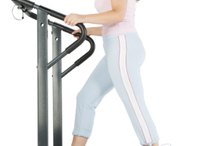What does fact checked mean?
At Healthfully, we strive to deliver objective content that is accurate and up-to-date. Our team periodically reviews articles in order to ensure content quality. The sources cited below consist of evidence from peer-reviewed journals, prominent medical organizations, academic associations, and government data.
- American Council on Exercise: Why Is the Concept of Spot Reduction Considered a Myth?
- Database of Abstracts of Reviews of Effects: A Meta-Analysis of Pedometer-Based Walking Interventions and Weight Loss
- Database of Abstracts of Reviews of Effects: A Meta-Analysis of Pedometer-Based Walking Interventions and Weight Loss
- American Journal of Physical Anthropology: EMG Activity Across Gait and Incline: The Impact of Muscular Activity on Human Morphology
- American Journal of Physical Anthropology: EMG Activity Across Gait and Incline: The Impact of Muscular Activity on Human Morphology
- Medicine and Science in Sports and Exercise: Energetics and Biomechanics of Inclined Treadmill Walking in Obese Adults
- Medicine and Science in Sports and Exercise: Energetics and Biomechanics of Inclined Treadmill Walking in Obese Adults
- Medicine and Science in Sports and Exercise: Greater Weight Loss from Running Than Walking During a 6.2-yr Prospective Follow-Up
- Medicine and Science in Sports and Exercise: Greater Weight Loss from Running Than Walking During a 6.2-yr Prospective Follow-Up
The information contained on this site is for informational purposes only, and should not be used as a substitute for the advice of a professional health care provider. Please check with the appropriate physician regarding health questions and concerns. Although we strive to deliver accurate and up-to-date information, no guarantee to that effect is made.
Does Walking Hills Help Slim Down Your Thighs?
A regular walking program improves your health and may help you lose a few pounds, but it won't guarantee that you'll be able to slide into a pair of skinny jeans anytime soon. Walking primarily uses the muscles of the legs and burns calories, but it may not be enough to promote the significant weight loss needed for you to get slimmer thighs -- even if you go uphill. You can't target a specific body part for reduction. To shrink your thighs, you'll need a complete weight-loss program that will cause you to lose weight all over -- including your thighs.
Troubled Thighs
For many women, and some men, the thighs are a "trouble" area. They stubbornly hold on to fat that you desperately wish to shed. Unfortunately, you can't control the places from which your body drops fat as you lose weight. The American Council on Exercise explains that this type of trouble zone can be one of the last areas that slims down when you lose weight -- but that doesn't mean you shouldn't try. A combination of regular cardiovascular exercise -- that includes walking -- plus resistance training and healthy, calorie-controlled eating leads to overall weight loss.
- For many women, and some men, the thighs are a "trouble" area.
- The American Council on Exercise explains that this type of trouble zone can be one of the last areas that slims down when you lose weight -- but that doesn't mean you shouldn't try.
Walking's Role
How to Get Skinny From Walking
Learn More
If you don't make any changes to your diet, you'll only lose modest weight with walking -- even up hills. A 30-minute walk at a moderately intensity pace of 3.5 mph and an incline of 5 percent burns about 214 calories for a 150-pound person. It takes 3,500 calories to lose a pound. Technically, even if you walk up this incline for an hour per day, it'll take almost eight days to lose one pound. In practice, the weight-loss results are slower. A meta-analysis of pedometer-based walking programs published in a 2008 issue of "Database of Abstracts of Reviews of Effects" showed only modest weight-loss results from walking programs without dietary changes 2. The average weight lost in nine different studies was 2.8 pounds after a median of 16 weeks. Only a fraction of those pounds are likely to be lost from your thighs.
- If you don't make any changes to your diet, you'll only lose modest weight with walking -- even up hills.
Don't Give Up on Hills
Hill-walking does burn more calories than level-ground walking, so it increases the intensity of your workout and thus can get you weight-loss results faster than if you stuck to flat roads. Hill walking provides more stimulation in your quadriceps and hamstrings than level ground walking. This may not make your thighs slimmer, but it can give them a more toned appearance. Add in two total-body resistance-training sessions weekly that include moves such as squats and lunges and you'll get even more thigh-muscle definition. If you combine regular hill-walking workouts with an eating plan that has you consuming fewer calories than you burn daily, you're more likely to experience weight-loss -- and thigh-slimming -- results.
- Hill-walking does burn more calories than level-ground walking, so it increases the intensity of your workout and thus can get you weight-loss results faster than if you stuck to flat roads.
Running Versus Hill Walking
Does Walking Help You Lose the Fat Around Your Waist?
Learn More
Running may be a better bet than walking when your goal is weight loss 5. A study in an April 2013 issue of "Medicine and Science in Sports and Exercise" showed that people who ran regularly showed a greater change in body-mass index than those who chose walking for exercise 45. While hill-walking may not give you as high a calorie burn as running, it is easier on the joints and more accessible for all fitness levels 6. Another study published in a July 2011 issue of "Medicine and Science in Sports and Exercise" concluded that uphill walking at a slower pace put less pressure on the joints of obese adults than walking fast on a flat terrain 45.
Related Articles
References
- American Council on Exercise: Why Is the Concept of Spot Reduction Considered a Myth?
- Database of Abstracts of Reviews of Effects: A Meta-Analysis of Pedometer-Based Walking Interventions and Weight Loss
- American Journal of Physical Anthropology: EMG Activity Across Gait and Incline: The Impact of Muscular Activity on Human Morphology
- Medicine and Science in Sports and Exercise: Energetics and Biomechanics of Inclined Treadmill Walking in Obese Adults
- Medicine and Science in Sports and Exercise: Greater Weight Loss from Running Than Walking During a 6.2-yr Prospective Follow-Up
- ShapeSense.com: Walking Calorie Burn Calculator
- Williams PT. Greater weight loss from running than walking during a 6.2-yr prospective follow-up. Med Sci Sports Exerc. 2013;45(4):706-13. doi:10.1249/MSS.0b013e31827b0d0a
- Cleveland Clinic. How To Start A Running Program For Beginners. Updated April 2020.
- Cox CE. Role of Physical Activity for Weight Loss and Weight Maintenance. Diabetes Spectr. 2017;30(3):157-160. doi:10.2337/ds17-0013
- Higdon H. Hal Higdon's Half Marathon Training. Human Kinetics. 2016.
- Williams PT. Greater weight loss from running than walking during a 6.2-yr prospective follow-up. Med Sci Sports Exerc. 2013;45(4):706-13.
Writer Bio
Andrea Boldt has been in the fitness industry for more than 20 years. A personal trainer, run coach, group fitness instructor and master yoga teacher, she also holds certifications in holistic and fitness nutrition.









